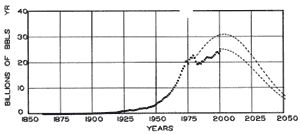1. Rising Oil Prices

Total World Oil Production “World oil production through the year 2000 is shown as heavy dots. The dashed lines on the right show the probable production ratesif the ultimate discoverable oil is 1.8 trillion barrels (the area under the lower curve) or 2.1 trillion barrels (upper curve).” –From Hubbert’s Peak: The ImpendingWorld Oil Shortage, by Professor Kenneth S. Deffeyes. His website is: http://www.princeton.edu/hubbert/Also see Hubbert Peak of Oil Production website: http://www.hubbertpeak.com/
2. LNG Dangers
“…[A]n uncontrolled release of LNG poses a serious hazard of explosion or fire…Experts have identified several potentially catastrophic events thatcould arise from an LNG release.” –Congressional Research Service “There is no possibility of ameliorating the fires’ effects, much lessextinguishing them…” –Dr. James Fay, MIT For information visit the Northcoast Environmental Center: http://www.necandeconews.to/
3. Countering Oil Dependence
“How much oil we import affects our economy and our national security. Today, more then half of the oil we use is imported. This level of dependence on imports(55%) is the highest in our history, and will increase as we use up domestic resources. The vast majority of the world’s oil reserves are concentrated in the Middle East (65%to 75%), and controlled by the members of the OPEC oil cartel.” –From U.S. Department of Energy, Fuel Economy website: www.fueleconomy.gov “Hydrogen is a long-term solution to America’s energy needs, with near-term possibilities. Efforts to achieve our energy goals need to begin now and continue with a sustained commitmentover the next several decades. It is important to strengthen our partnerships among government, industry, and others in order to improve hydrogen technologies and systems, and to build the infrastructure–both physicaland institutional–that will be needed in the years ahead. The tragic events of September 11, 2001, highlight the urgency of making progress toward greater energy security.”–From the U.S. Department of Energy Report: Toward a More Secure and Cleaner Energy Future for America: A National Vision of America’s Transition to a Hydrogen Economy–To 2030 and Beyond.Download the report at: http://www.eere.energy.gov/hydrogenandfuelcells/pdfs/vision_doc.pdf
4. Opportunities for Energy Efficiency
If every household in the U.S. switched one 100W incandescent light bulb that is used for 4 hours per day to a compact florescent bulb, it would save 7billion kWh per year–enough energy to power 800,000 homes. For more information on energy efficiency: U.S. Department of Energy,Energy Efficiency and Renewable Energy website http://www.eere.energy.gov/
5. Cost-effectiveness of Renewables
Wind Power Potential: “Good wind areas, which cover 6% of the contiguous U.S. land area, havethe potential to supply more than one and a half times the current electricity consumption of the United States.” ÐU.S. Department of Energy For more information, visit the DOE Energy Efficiency and RenewableEnergy’s Wind Powering America website: www.windpoeringamerica.gov
6. Creation of New Jobs
“Labor, Environment, Civil Rights, Business and Political Leaders Unite Behind Ambitious Energy Independence and Jobs Program: New Study FindsStrategic Investments in Clean Energy and Efficiency Would Create 3.3 Million High-Wage Jobs and Pay for Itself” The New Apollo Energy Project “will create well over 3 million highwage jobs in construction, manufacturing, and industrial machinery by 2015, building new and efficient infrastructure and accelerating the next generation ofcutting edge technology. Those jobs will pour $95 billion back into the economy through new income, and $330 billion in additional economic output, and helps provide needed assistance to state and local governments.It is time to reinvest in America, it is time to rebuild. We must do it, not because it is easy, but because it is hard and necessary.”– www.apolloalliance.org
7. Reducing the Risks of Climate Change
“There is substantial evidence to indicate that significant global warming will occur during the 21st century. Because changes have been gradual so far, and are projected to be similarly gradual in the future, theeffects of global warming have the potential to be manageable for most nations. Recent research, however, suggests that there is a possibility that this gradual global warmingcould lead to a relatively abrupt slowing of the ocean’s thermohaline conveyor, which could lead to harsher winter weatherconditions, sharply reduced soil moisture, and more intense winds in certain regions that currently provide a significant fraction of theworld’s food production. With inadequate preparation, the result could be a significant drop in the human carrying capacity of theEarth’s environment.” –From the Pentagon Report; An Abrupt Climate Change Scenarioand Its Implications for United States National Security Downloadable at Environmental Media Services:http://www.ems.org/climate/pentagon_climate_change.html
“The Earth’s climate is changing. The build-up of carbon dioxide and other greenhouse gases in the atmosphere has sent temperatures rising and put the cycles of storms and seasons on an uncertain course. Manyspecies and ecosystems, already at risk from other pressures, will be pushed beyond their natural ability to adapt by the pace and severity of threats now posed by climate change.”–From The Nature Conservancy’s Climate Change site: http://nature.org/initiatives/climatechange/